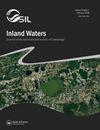Structure and diversity of bacterial communities in the water column of three reservoirs in Yun-Gui Plateau, China
IF 2.3
3区 环境科学与生态学
Q1 LIMNOLOGY
引用次数: 0
Abstract
ABSTRACT Plateau reservoirs are considered vulnerable and sensitive to eutrophication under global warming and land use changes. We investigated the structure, diversity, and gene functions of bacterial communities in 3 reservoirs in Yun-Gui Plateau. We assumed the bacterial community structures were different among these 3 plateau reservoirs because of differences in trophic status. We found an insignificant difference in bacterial community structure among the reservoirs but a varying relative abundance of components in the community. Proteobacteria and Cyanobacteria were the most abundant phyla. Alpha diversity, as indicated by Simpson, Shannon, and evenness indexes, were similar in the 3 reservoirs, but richness was different. Hongfeng Reservoir exhibited the lowest heterogeneity, as indicated by the beta diversity. Analysis of gene functions suggested that amino acid metabolism and membrane transport were important and reflected the multiple roles of bacteria in biogeochemical processes. This study provided information about the bacterial community structure in reservoirs of Yun-Gui Plateau and analysis of the effects of environmental factors. Bacterial communities show little variation among reservoirs due to exposure to similar environmental conditions, and differences in trophic status were not a strong driver of community structure changes.云贵高原3个水库水柱细菌群落结构与多样性
本文章由计算机程序翻译,如有差异,请以英文原文为准。
求助全文
约1分钟内获得全文
求助全文
来源期刊

Inland Waters
LIMNOLOGY-MARINE & FRESHWATER BIOLOGY
CiteScore
6.10
自引率
9.70%
发文量
34
审稿时长
>12 weeks
期刊介绍:
Inland Waters is the peer-reviewed, scholarly outlet for original papers that advance science within the framework of the International Society of Limnology (SIL). The journal promotes understanding of inland aquatic ecosystems and their management. Subject matter parallels the content of SIL Congresses, and submissions based on presentations are encouraged.
All aspects of physical, chemical, and biological limnology are appropriate, as are papers on applied and regional limnology. The journal also aims to publish articles resulting from plenary lectures presented at SIL Congresses and occasional synthesis articles, as well as issues dedicated to a particular theme, specific water body, or aquatic ecosystem in a geographical area. Publication in the journal is not restricted to SIL members.
 求助内容:
求助内容: 应助结果提醒方式:
应助结果提醒方式:


